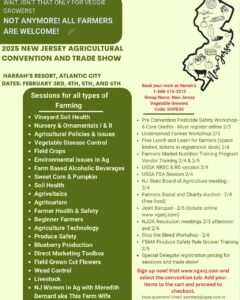NORTH JERSEY COMMERCIAL
FRUIT GROWERS MEETING
March 5, 2025
8:30 am – 3:30 pm
Hunterdon County Complex
314 State Route 12, Bldg. 1
Flemington, NJ
Program
Program Chair
Megan Muehlbauer, PhD
Agriculture and Resource Management Agent
Cooperative Extension of Hunterdon County
8:30 – Registration
Coffee and pastry, compliments of industry sponsors
9:00 – Welcome and Introductions
9:10 – North Jersey Tree Fruit IPM Updates
Kaitlin Quinn, North Jersey Fruit IPM Program Associate, Cooperative Extension
9:40 – Mycorrhizal Fungi Applications and their Effect on Soil Biology and Tree Health
Megan Muehlbauer PhD, ANR Agent, Cooperative Extension of Hunterdon
10:10 – Pest Updates for Tree Fruit in North Jersey
Anne Nielsen PhD, Specialist in Fruit Entomology, Cooperative Extension
10:40 – Weed Management Technologies for the Orchard and Vineyard
Thierry Besançon, Specialist in Weed Science, Cooperative Extension
11:10 – Compliance in Pest Management: Status Update for Chlorpyrifos and the Endangered Species Act
Janine Spies PhD, Statewide Program Leader and Agriculture Agent in Fruit IPM, Cooperative Extension
11:40 – Update on Farm Service Programs
Laura LaFevre, County Executive Director, Hunterdon/Somerset Office, Farm Service Agency
11:50 – Jersey Fresh Marketing Update
Joe Atchison III, Assistant Secretary, NJ Dept. of Agriculture
Christine Fries, Coordinator of Agricultural Marketing, NJ Dept. of Agriculture
12:00 – LUNCHEON (pre-registration required)
12:50 – What is New from Industry
1:10 – Understanding How Irrigation Water can be a Source for Soilborne Diseases in the Orchard
Kari Peter, Associate Research Professor Tree Fruit Pathology, Penn State University
1:40 – Bitter Rot in Apples What we Know and How to Control it
Kari Peter, Associate Research Professor Tree Fruit Pathology, Penn State University
2:10 – Pesticide Protection, Precautions and Procedures
Spencer Kerkhof, Environmental Specialist, Pesticide Compliance & Enforcement NJDEP
2:40 – What can the Rutgers Diagnostic Lab do for You
Rich Buckley, Director of the New Jersey Soil Testing & Diagnostic Services
Sabrina Tirpak, Laboratory Researcher II, Plant Diagnostic Laboratory Rutgers
3:10 – Pesticide Recertification Credits and Adjourn
NJDEP PESTICIDE RECERTIFICATION CREDITS ARE ANTICIPATED
Click here and fill out this form to register for the meeting then fax or email to:
Fax: (908) 806-4735
E-mail: kfrey@co.hunterdon.nj.us
If you have any questions please call Kim Crommelin: (908)-788-1338




